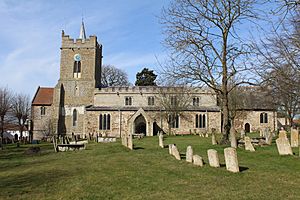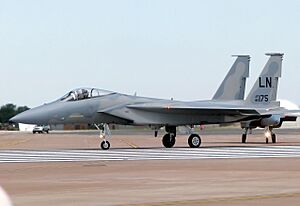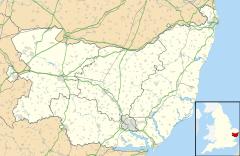Lakenheath facts for kids
Quick facts for kids Lakenheath |
|
|---|---|
 Church of St Mary the Virgin |
|
 Goward house |
|
| Population | 4,691 (2011 Census) |
| OS grid reference | TL715825 |
| • London | 80.72 from High Street to Parliament Square |
| Civil parish |
|
| District |
|
| Shire county | |
| Region | |
| Country | England |
| Sovereign state | United Kingdom |
| Post town | Brandon |
| Postcode district | IP27 |
| Dialling code | 01842 |
| Police | Suffolk |
| Fire | Suffolk |
| Ambulance | East of England |
| EU Parliament | East of England |
| UK Parliament |
|
Lakenheath is a village in eastern England, located in the West Suffolk area of Suffolk. In 2011, about 4,691 people lived there. It's close to the borders of Norfolk and Cambridgeshire. Lakenheath is also where two special natural areas meet: The Fens (a flat, marshy region) and the Breckland (a dry, sandy area).
Lakenheath is home to the biggest United States Air Force base in the United Kingdom, called RAF Lakenheath.
The Lakenheath Fen Nature Reserve was created in 1996. This special place used to be farm fields where carrots grew. Now, it's a restored wetland. In 2007, something amazing happened: cranes nested there for the first time in centuries! This was a big deal because the fen lands had been drained way back in the 1500s.
The village has a primary school built in 1878, which has been made bigger several times. There's a small street with different shops, restaurants, and services. You can also find horse-riding services here. Lakenheath also has a modern library, a small hotel, a skate park, and a children's play park.
Lakenheath has two pubs, but long ago, it had many more. The Plough Inn (also known as the Wok n Rock) is a large pub with a restaurant. The other pub is called the Brewer's Tap.
The village is famous for its old church, built about 900 years ago. It was first made of wood, then rebuilt using local flint stone. The outside of the church has a special top edge with carved faces and creatures called gargoyles. Inside, you can see old paintings and carvings on the wooden seats. Some of the church's wooden angels have damaged faces. This happened during the English Civil War when soldiers, called puritans, damaged them because of their religious beliefs. In 2009, the church got money to help restore its rare medieval wall paintings. These paintings, from the 1200s, show St Edmund, angels, and birds.
Besides the main Anglican church, Lakenheath also has churches for Methodist, Strict Baptist, and Pentecostal groups. These church buildings are also mostly made of local flint stone.
A new building called the pavilion is now home to the local cricket club. It also hosts different events.
Lakenheath also has a football club that plays at 'The Pit' stadium. In 2021, the club moved up to a higher league called the Thurlow Nunn League Premier Division. This is the highest they have ever been! They also won the Suffolk Senior Cup for the second time.
Contents
Getting Around Lakenheath
Lakenheath railway station is about 3 miles (5 km) north of the village. Not many passenger trains stop there.
There are regular bus services to nearby towns like Brandon, Mildenhall, and Thetford. Buses also go to Bury St. Edmunds on school days, and anyone can use them.
RAF Lakenheath: A US Air Force Base

Lakenheath is home to the largest group of United States Air Force people in the UK. This base, RAF Lakenheath, and its nearby sister base, RAF Mildenhall, are very important for the local economy. The US Air Force has been in the area since World War II, when bombers were based there. Today, about 6,000 service members live and work at the base.
Ancient Discoveries in Lakenheath
During the Ice Age, a river called the River Bytham flowed through what is now Lakenheath. This river left behind many of the rocks and soil found in the area today.
Between 1997 and 2002, archaeologists dug up three old Anglo-Saxon cemeteries at RAF Lakenheath. They found 394 human burials and 17 cremation burials. One special grave from the 500s had a man buried next to a fully armored horse!
Lakenheath's Past
In 1381, during the Peasants' Revolt, a very important judge named Sir John Cavendish was chased by rebels. He was caught and killed in Lakenheath.
On November 23, 1981, a small tornado hit the village. This was part of a record-breaking day for tornadoes across the UK.
Lakenheath's Weather
Lakenheath has an oceanic climate, which is similar to the rest of eastern England. This means it's usually warmer and drier than other parts of the British Isles. This is because it's further away from the stormy weather systems that come from the Atlantic Ocean.
| Climate data for Lakenheath, 1981-2010 | |||||||||||||
|---|---|---|---|---|---|---|---|---|---|---|---|---|---|
| Month | Jan | Feb | Mar | Apr | May | Jun | Jul | Aug | Sep | Oct | Nov | Dec | Year |
| Record high °C (°F) | 16 (61) |
18 (64) |
22.8 (73.0) |
27 (81) |
29 (84) |
34 (93) |
34 (93) |
35 (95) |
31.1 (88.0) |
29.1 (84.4) |
18 (64) |
15 (59) |
35 (95) |
| Mean daily maximum °C (°F) | 7.3 (45.1) |
8.4 (47.1) |
10.9 (51.6) |
14.2 (57.6) |
17.5 (63.5) |
20.5 (68.9) |
22.6 (72.7) |
22.4 (72.3) |
19.6 (67.3) |
15.4 (59.7) |
10.8 (51.4) |
7.0 (44.6) |
14.8 (58.6) |
| Daily mean °C (°F) | 4.6 (40.3) |
5.6 (42.1) |
7.1 (44.8) |
9.5 (49.1) |
12.8 (55.0) |
15.8 (60.4) |
18.0 (64.4) |
17.8 (64.0) |
15.2 (59.4) |
11.7 (53.1) |
7.7 (45.9) |
4.3 (39.7) |
10.9 (51.6) |
| Mean daily minimum °C (°F) | 1.8 (35.2) |
1.8 (35.2) |
3.2 (37.8) |
4.8 (40.6) |
8.1 (46.6) |
11.0 (51.8) |
13.5 (56.3) |
13.1 (55.6) |
10.7 (51.3) |
7.9 (46.2) |
4.6 (40.3) |
1.7 (35.1) |
6.9 (44.4) |
| Record low °C (°F) | −15.6 (3.9) |
−13.3 (8.1) |
−10 (14) |
−6.1 (21.0) |
−3.3 (26.1) |
−1.7 (28.9) |
3.3 (37.9) |
2.6 (36.7) |
0.6 (33.1) |
−5 (23) |
−8.3 (17.1) |
−13.9 (7.0) |
−15.6 (3.9) |
| Average precipitation mm (inches) | 67.2 (2.65) |
65.6 (2.58) |
43.5 (1.71) |
31.8 (1.25) |
40.5 (1.59) |
55.5 (2.19) |
45.7 (1.80) |
58.0 (2.28) |
37.8 (1.49) |
48.1 (1.89) |
56.8 (2.24) |
52.1 (2.05) |
598.9 (23.58) |
| Source: Météo Climat | |||||||||||||
See also
 In Spanish: Lakenheath para niños
In Spanish: Lakenheath para niños


